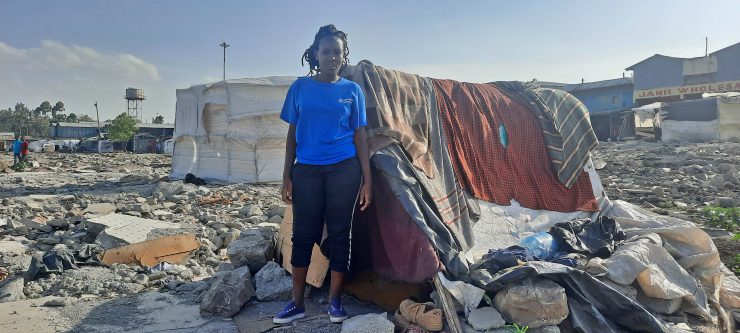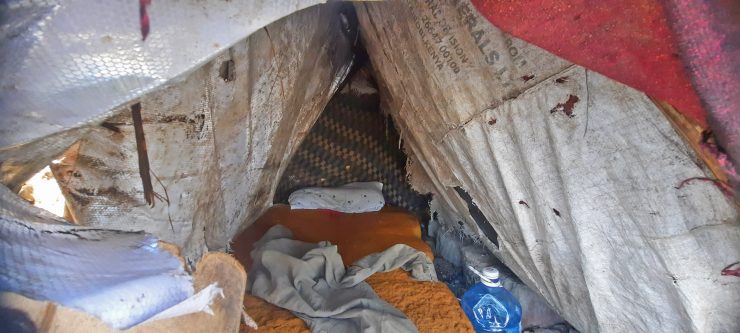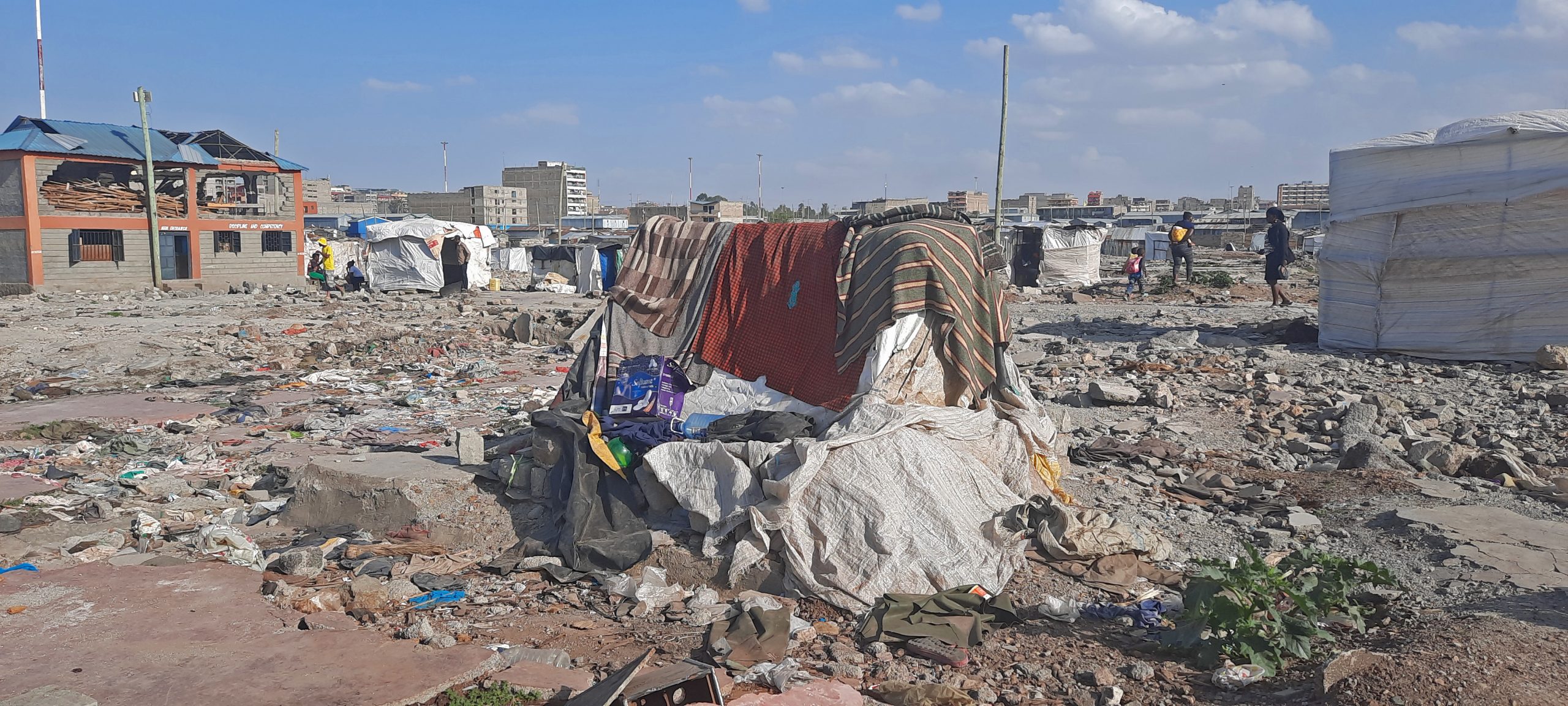Minoo Kyaa was having a rough morning. She’d witnessed bulldozers flatten hundreds of houses in her Mukuru Kwa Njenga neighborhood. Three days earlier, word on the street had been that an eviction was imminent, to make way for a road linking the Nairobi Expressway – a Chinese-backed toll road flying over Nairobi – and the city’s bustling Industrial Area. The new road would cut right through Mukuru Kwa Njenga, as if splitting the settlement into two equal halves. The same fate of demolitions to create room for a road had happened in Kibra in 2018.
Nothing formal had been communicated by the authorities regarding the Mukuru evictions, but as if fulfilling a prophecy, bulldozers showed up as foretold and flattened Mukuru’s Sisal area, crushing people’s homes into rubble. For Minoo – who comes from the next village called Milimani – it was a bitter-sweet relief that her house wasn’t hit, much as she was devastated by what she saw happening to her neighbours. But alas! While taking a nap that afternoon, Minoo was awakened by eerie screams. The outside seemed chaotic, dreamily. They had come for her.
Scuffles had broken out between Kwa Njenga residents and government officials tasked with getting the roads-first-people-later job done. The heavy Nairobi Metropolitan Services (NMS)-branded machinery had reached Minoo’s Milimani village, three bulldozers and four water cannons flanked by General Service Unit (GSU) troopers. Enraged youths engaged the police in running battles that ended with some taking injuries from tear gas canisters and bullets.
Fearing exposure to the larger Kenyan public especially through social media, the we-mean-business-looking enforcers allowed nobody to document the happenings either through photos or videos, the now prevalent form of mobile phone-powered citizen journalism.
If caught going against the cardinal rule to not document the demolitions, there would be no hesitation in one’s phone getting snatched and thrown under the weight of bulldozers, to suffer the same flattening fate Kwa Njenga houses were facing.
But even so, Minoo and other defiant residents managed to get a few shots of the goings-on, sending them out to their WhatsApp contacts. The world needed to know what was happening. It was out of these videos by the likes of Minoo and others that the situation in Mukuru permeated media and civil society spaces, with images of thousands of residents seeking refuge from the rain in makeshift structures made out of debris from their previous homes being the order of the day.
On that fateful night, I come to learn belatedly, a woman gave birth while out in the rough and with no medical assistance. She ended up losing her baby due to exposure to the elements. Those in charge of the evictions may not beware that they caused death in this and other ways.
“It was a day when trust and betrayal, power and weakness, all played a tug-of-war,” Minoo tells me as she points to the wreckage that was once her home of 26 years, her mother on standby to corroborate. “Manu Chandaria gave us the piece of land and said it was his donation to the poor,” Mama Minoo alleges after telling me she moved to Mukuru Kwa Njenga in July 1995, having been evicted from elsewhere – which makes the current evictions some form of deja vu. “No one evicted us after that, and that’s how we gradually built our houses over the years. They were iron-sheet shacks, but at least we had a place to call home.”

Mama Minoo recalls being under the weather when the demolitions happened, narrating painfully how her husband spent up all his National Social Security Fund (NSSF) benefits to renovate their house barely three years ago before it was crushed into a pulp. With the house gone, the family opted to sell off their iron sheets cheaply as scrap metal. It was way better than leaving the material exposed to petty thieves.
The Backstory: For a long time, the 100 acre piece of land surrounded by the Industrial Area, the Imara Daima Housing Development, the Jomo Kenyatta International Airport (JKIA) and the Standard Gauge Railway (SGR) has been the center of major legal disputes. According to Civil Suit 146 of 1999, the parcel of land was bought from the National Bank of Kenya Limited (NBK) in 1987 by a private firm, Orbit Chemical Industries, as property LR 12425. The plan was to build a factory, but when the firm took long before embarking on the construction project, individuals seeking a home moved in. Over time, the endless court wrangles would lead the company to donate some plots in 2018 to schools, churches and public facilities and sell off the rest in bits, according to Sachen Chandaria, CEO of Orbit Chemical Industries.
The False Promise: While visiting the Kwa Njenga Primary School in January 2015, President Uhuru Kenyatta directed then Lands Cabinet Secretary, Charity Ngilu, to settle the squatters and issue them with title deeds. This, and the 2019 declaration by the Nairobi County Government that all the 550 acres of land covering Mukuru Kwa Njenga, Mukuru Kwa Reuben and Viwandani wards fall under the Special Planning Area (SPA), proffered relief on residents. But the consistently delayed promise of reinstatement has stalled its implementation. The SPA sought to bring an infrastructural facelift by improving access to water and sanitation, electricity connectivity, healthcare, construction of 15,000 modern housing units, the drilling of ten boreholes and issuance of 1,329 title deeds under the Integrated Development Plan 2018-2022.
In delivering the President’s message in Mukuru following outrage over the demolitions, Major General Mohamed Badi, the NMS Director General said residents were allowed to rebuild their homes so long as there would be no interference in the road construction. Badi further pledged that President Kenyatta would personally finance the procurement of re-construction materials.
“But why did they demolish our houses in the first place?’’ Mama Minoo asks bitterly. ‘‘So that they can save us with building material? What about the destroyed property?”

However, three months on, it is still nights in the cold for many families in Mukuru, discarded souls whose emergency has never been urgent enough for Kenya. To date, there has neither been any official communication about resettlement or any clear demarcations where residents are to rebuild their homes. In the meantime, for these particular Mukuru residents, home remains home even if it’s simply scattered remnants of what they once called home. For them, Mukuru is home.
(The case of forced evictions – or threats of the same – in informal settlements isn’t new to Mukuru or Nairobi. In August 1996, the eviction of 20,000 people from the Mukuru shantytown was ordered by the Moi regime and then quickly suspended. Two days later, it was the turn of Mbagathi Village (between South C and Langata Road) to be destroyed. Going further back, in 1969, in Kaburini in Eastleigh, 370 families were evicted from their homes only to be awarded a Site and Service Scheme near Karura Forest five years later. The village of Kibagare in Kangemi would also suffer the same fate of forceful eviction in 1990. Later the same year, an eviction was demanded of families who had rebuilt on the site. The list is long and growing.)

